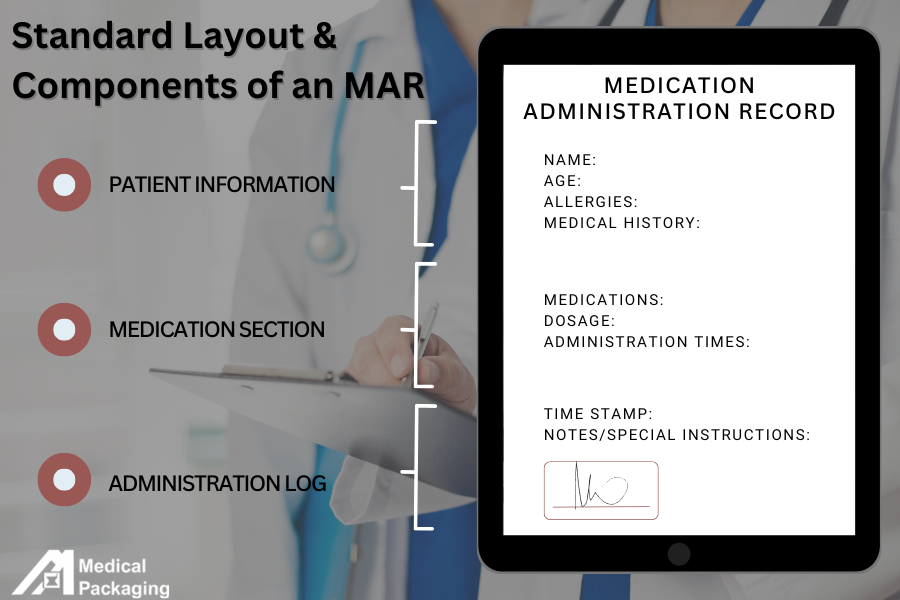What is a Medication Administration Record?
In healthcare, ensuring that patients receive the correct medication, at the correct dose and time, is essential to their safety and well-being. A Medication Administration Record (MAR) is a critical tool that helps achieve this accuracy. Used across healthcare settings, a MAR provides a comprehensive, organized record of each medication administered to a patient. This vital document supports healthcare providers by tracking doses, preventing errors, and providing a clear record of care.
Whether paper-based or digital, MARs are essential in:
- Preventing Errors: By cross-checking patient information, medication details, and schedules, MARs reduce the risk of administering incorrect doses.
- Ensuring Accountability: Each dose, time, and provider are logged for an accessible record of care, supporting continuity.
- Supporting Safe and Effective Care: MARs provide an organized format for tracking medication administration, ensuring that providers can quickly confirm correct dosages and any special instructions.
Key Features of a Medication Administration Record
A MAR is more than just a log—it is a standardized record that organizes essential information about a patient and their prescribed medications. This structured format allows healthcare providers to keep track of every detail, ensuring that nothing is overlooked.
Here is what you will typically find in a MAR:
- Patient Information: Includes critical identifying information, such as name, age, and medical record number, ensuring the right patient receives the correct treatment.
- Medication Details: Lists each prescribed medication’s name, dosage, form (e.g., tablet, liquid), and route of administration (e.g., oral, intravenous).
- Prescribing Healthcare Provider: Details the medical professional responsible for prescribing each medication.
- Administration Schedule: Specifies when each medication should be administered, including the time and frequency for every dose.
- Additional Instructions: Notes any special instructions, such as taking with food, and guidance for monitoring specific reactions or side effects.
With these key features, a MAR ensures that each healthcare provider has the necessary information to administer medications confidently and safely, maintaining consistency and accuracy in treatment.
Types of Medication Administration Records
Different healthcare settings call for variations in MARs to suit unique needs and protocols. These records fall into three main types, each designed to optimize care in specific environments:
Inpatient MARs
Inpatient MARs are commonly used in high-need environments like hospitals and long-term care facilities, where patients receive medications directly from healthcare providers. In such settings, strict dosing schedules and close monitoring are critical, making inpatient MARs essential for organizing and recording frequent doses. Inpatient MARs ensure that every provider can see updated records in real time, reducing the risk of missed doses or duplicated entries and supporting collaborative care.
Outpatient MARs
In outpatient settings—such as clinics or home health environments—patients may have more autonomy over their medication, yet documentation remains essential. Outpatient MARs help healthcare providers, caregivers, and sometimes patients themselves stay on track, particularly for complex medication regimens. These MARs can help facilitate patient independence while ensuring there is a clear record for healthcare providers to review and adjust as needed.
Electronic MARs (eMAR)
eMARs offer healthcare providers a modern, digital approach to MARs. These electronic records integrate with broader healthcare systems, providing seamless access and real-time updates. eMARs reduce human error by automating reminders for upcoming doses, alerting providers to potential drug interactions, and syncing with Electronic Health Records (EHRs) to give a complete view of patient health. Advantages include:
- Real-Time Access: Allows all authorized providers immediate access to the latest records.
- Enhanced Safety Alerts: Many eMAR systems alert staff to potential missed doses or incorrect entries.
- Integration with Other Systems: Syncs with EHRs to offer a comprehensive patient history, improving coordination across providers.
The Role of MARs in Promoting Patient Safety
Medication errors pose significant risks in healthcare, and MARs play a key role in minimizing these risks. By acting as a reliable reference for medication details, administration times, and dosing schedules, MARs directly support patient safety in the following ways:
Reducing Medication Errors
Errors in medication can occur from miscommunication, misinterpretation of prescription details, or unclear schedules. MARs provide a detailed, structured format that helps prevent these mistakes. Whether through double-checking patient information, cross-referencing the prescribed dose, or confirming medication routes, MARs are a primary defense against potentially dangerous errors.
Supporting Regulatory Compliance
In the healthcare field, regulatory compliance is critical. Healthcare facilities must meet rigorous documentation standards to ensure patient safety, and MARs provide the foundation for this compliance. With a clear record of every dose administered, facilities can meet audits, inspections, and other regulatory requirements while maintaining accountability.
Enhancing Communication Across Healthcare Teams
Effective communication among healthcare providers is essential for high-quality patient care. MARs serve as a central communication tool, especially in busy environments like hospitals, where multiple providers may administer medications to a single patient. By maintaining accurate, accessible records, MARs reduce the risk of miscommunication, enabling a coordinated approach to patient care.
Standard Layout and Components of a MAR
To facilitate quick, accurate medication administration, MARs follow a standardized layout that includes several key sections:
- Patient Information Section: Basic patient details, including identification and allergies.
- Medication Section: A comprehensive list of medications with doses, administration times, and routes.
- Administration Log: Space for timestamps, provider signatures, and any notes or special instructions.
MARs also frequently use common symbols and abbreviations, like NPO (nothing by mouth) or IV (intravenous), to save space and avoid ambiguity. These standardized elements make MARs user-friendly, allowing healthcare providers to document and interpret medication administration quickly and accurately.
Step-by-Step Guide to Using a MAR
Healthcare providers follow a structured process for using a MAR to administer medications. This process promotes accuracy and consistency:
- Initial Review: Providers review the MAR and patient records to confirm scheduled medications and any specific instructions.
- Identity Verification: Verifying the patient’s identity ensures the correct medication reaches the right individual.
- Medication Preparation: Prepare each dose according to MAR instructions, including any special handling.
- Administration and Documentation: Administer the medication, note the time, and record any observations.
- Post-Administration Monitoring: Monitor for side effects or reactions and update the MAR as needed.
By following these steps, healthcare providers maintain consistent, safe medication administration practices and reduce the chance of errors.
Overcoming Challenges in Medication Administration with MARs
Medication administration has challenges, but MARs offer a structured solution to mitigate these risks. Some common issues in medication administration include:
- Missed Doses: With high patient volumes, missed doses are possible without clear records.
- Administration Errors: Without MARs, providers risk administering incorrect doses or medications.
- Drug Interactions: Patients with multiple prescriptions may face adverse interactions if doses are not tracked closely.
How MARs Mitigate These Challenges
MARs help reduce the risk of missed doses, administration errors, and drug interactions. Electronic MARs are particularly effective, providing automated reminders and alerts to ensure that providers follow medication schedules precisely and respond to potential drug interactions in advance.
The Future of MARs in Healthcare
With the rapid pace of technological advancement, MARs are evolving to meet modern healthcare demands. Two primary trends in MAR development are:
Integration with Advanced Technologies
Technologies like artificial intelligence (AI) and data analytics are becoming integral to MARs. These advancements offer predictive insights, helping healthcare providers anticipate patient needs, identify potential drug interactions, and make data-driven decisions to enhance patient safety.
Synchronization with Electronic Health Records (EHRs)
By integrating with EHRs, MARs offer a full, synchronized view of patient health. This integration allows healthcare providers to see a patient’s medication history alongside other health data, providing a more holistic view of patient care and improving communication across healthcare teams.
MPI’s Role in Supporting Medication Administration
Medical Packaging Inc., LLC (MPI) supports healthcare providers by offering advanced unit dose packaging solutions and labeling software designed to work seamlessly with MARs. MPI’s unit dose packaging systems allow healthcare facilities to prepare medications with clear labeling and precise dosing, streamlining the administration process.
Accurate labeling and efficient inventory management are crucial to safe medication administration, and MPI’s Pak-EDGE® UD Barcode Labeling Software complements the MAR process by enhancing these areas. With a customizable label design, Pak-EDGE® ensures that each unit dose is clearly labeled with essential information that aligns seamlessly with MAR entries.
The software’s advanced barcode capabilities (1D, 2D, and GS1 formats) enable quick, precise scanning, reducing the risk of errors in MAR documentation. Additionally, centralized network support allows real-time medication updates across facilities, providing healthcare providers with instant access to accurate data.
MPI’s solutions enhance patient safety, regulatory compliance, and workflow efficiency, making it easier for healthcare providers to ensure patients receive the correct dose at the correct time. Contact our team today to see how our products can simplify your medication administration process!
Resources:
“Electronically Generated Medication Administration and Electronic Medication Administration Records for the Prevention of Medication Transcription Errors: Review of Clinical Effectiveness and Safety.” National Center for Biotechnology Information, U.S. National Library of Medicine, 8 Dec. 2016, www.ncbi.nlm.nih.gov/books/NBK424213/.
Content
- Key Features of a Medication Administration Record
- Types of Medication Administration Records
- The Role of MARs in Promoting Patient Safety
- Standard Layout and Components of a MAR
- Step-by-Step Guide to Using a MAR
- Overcoming Challenges in Medication Administration with MARs
- The Future of MARs in Healthcare
- MPI’s Role in Supporting Medication Administration
- Resources:
Contact MPI Today for Personal Assistance
MPI’s Drug Master File provides speed-to-market regulatory and technical support related to our packaging components for medical and pharmaceutical market clients
